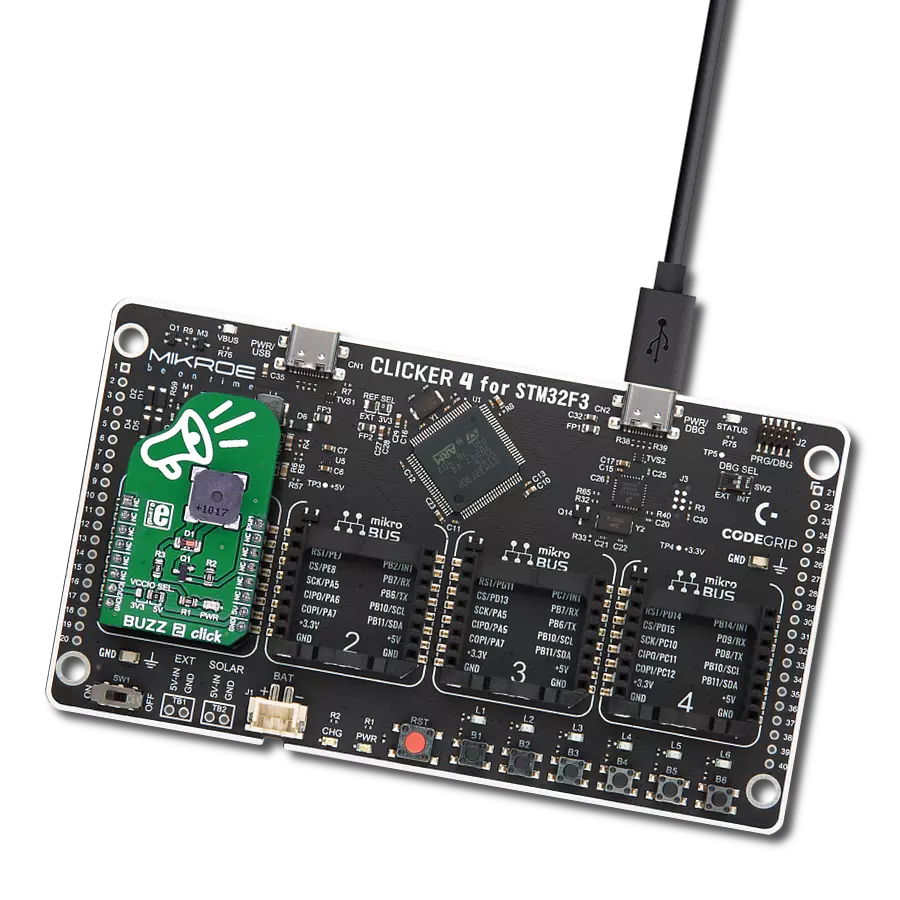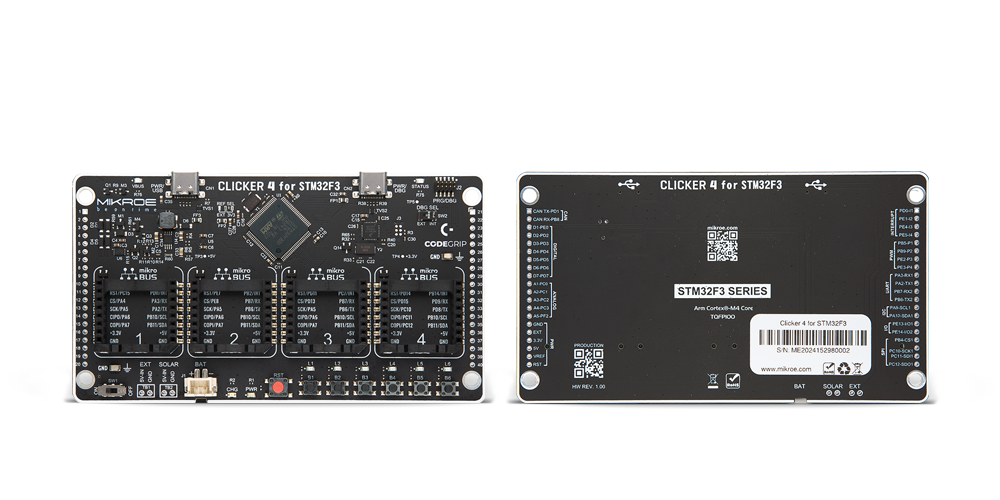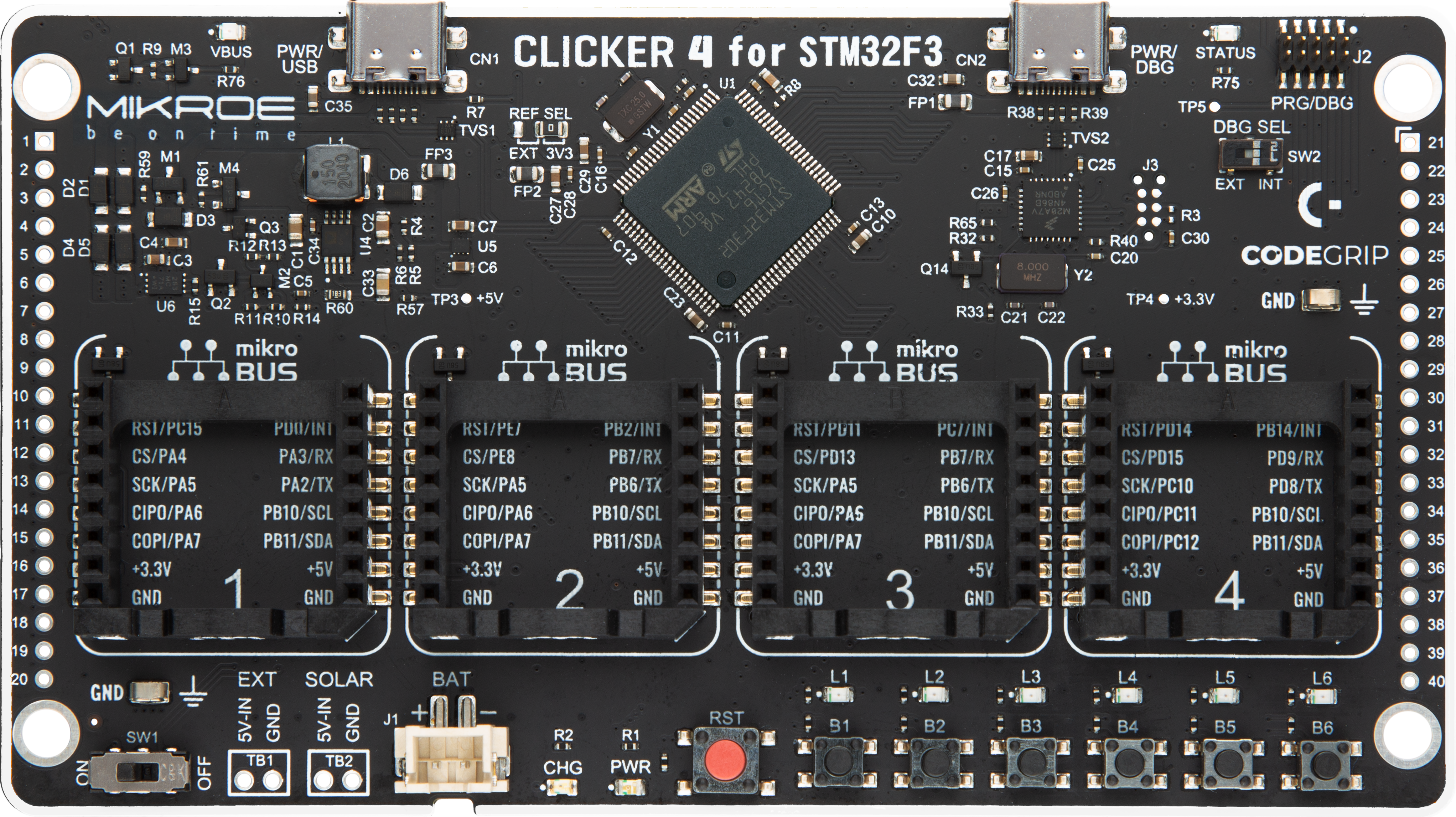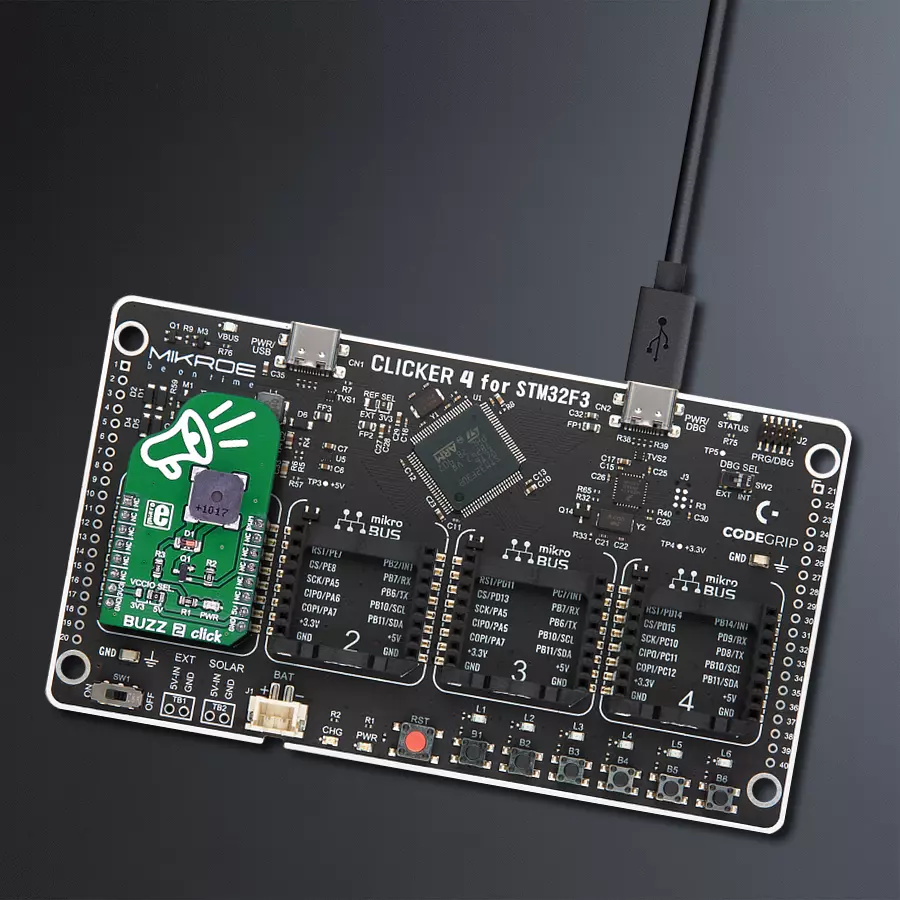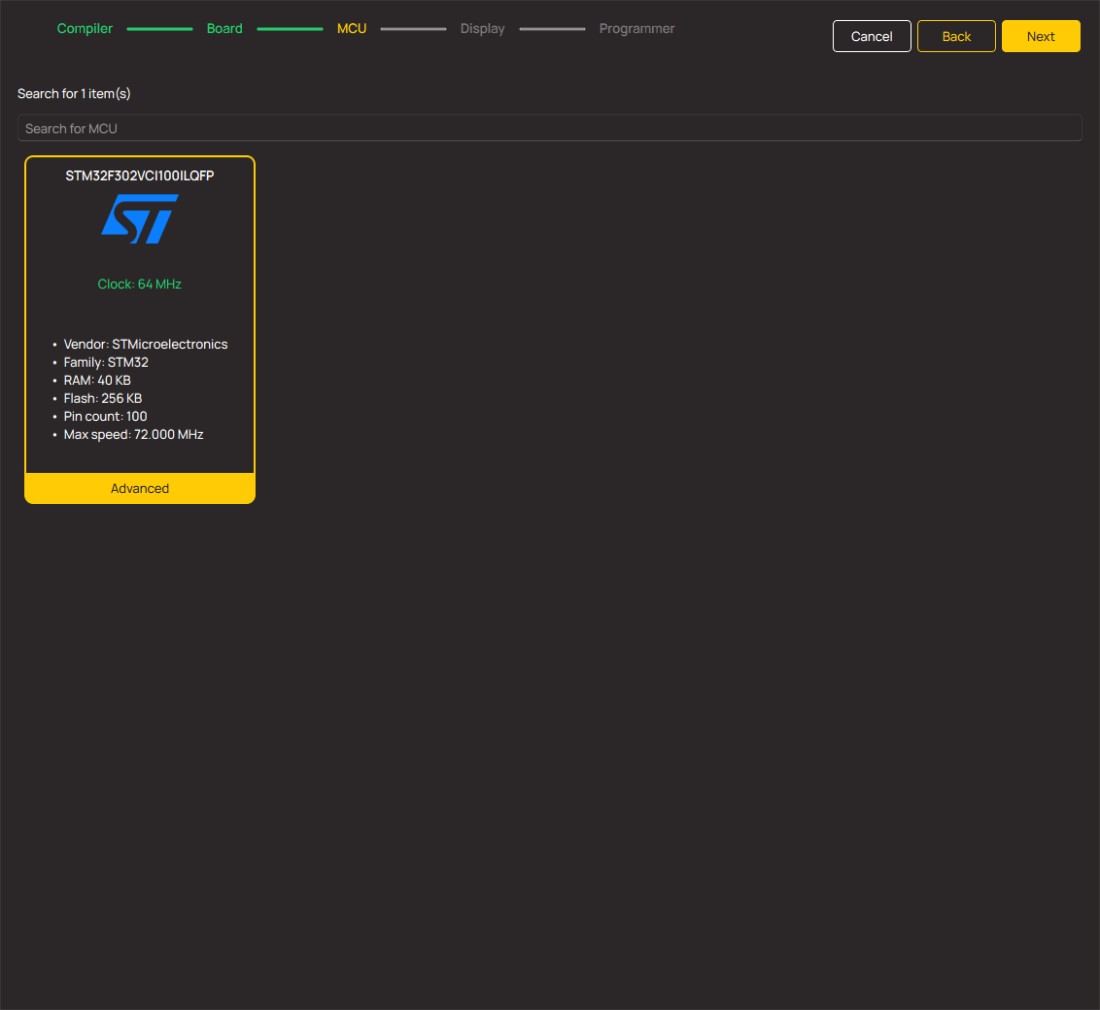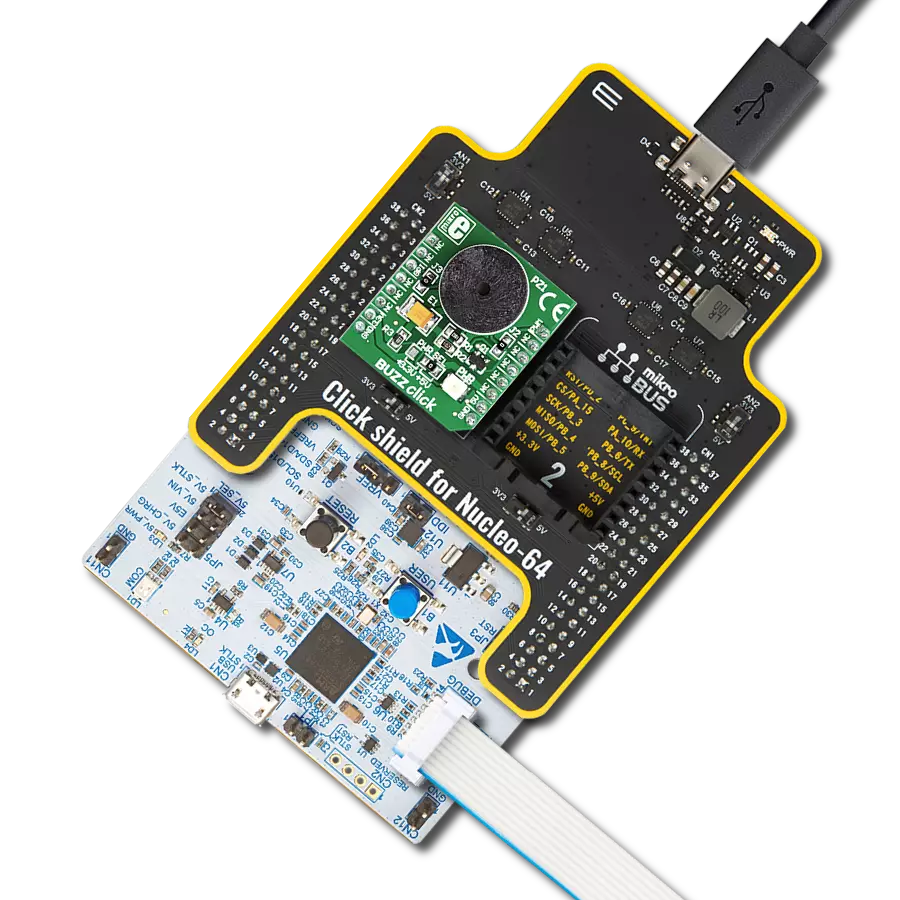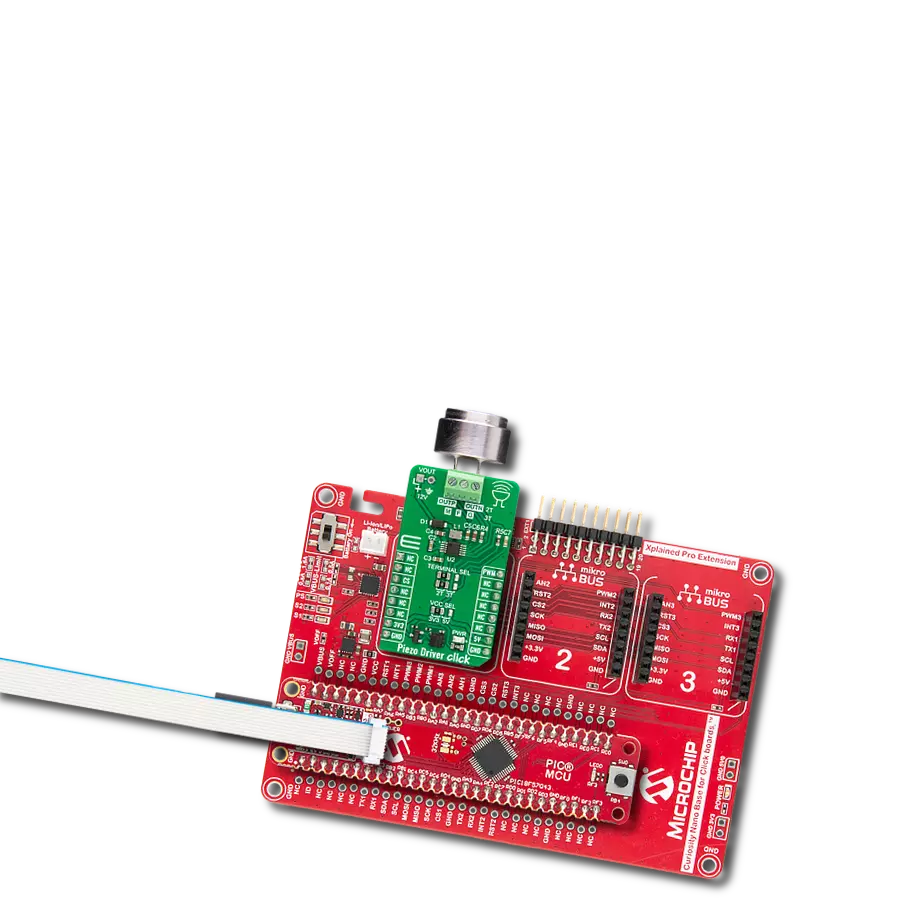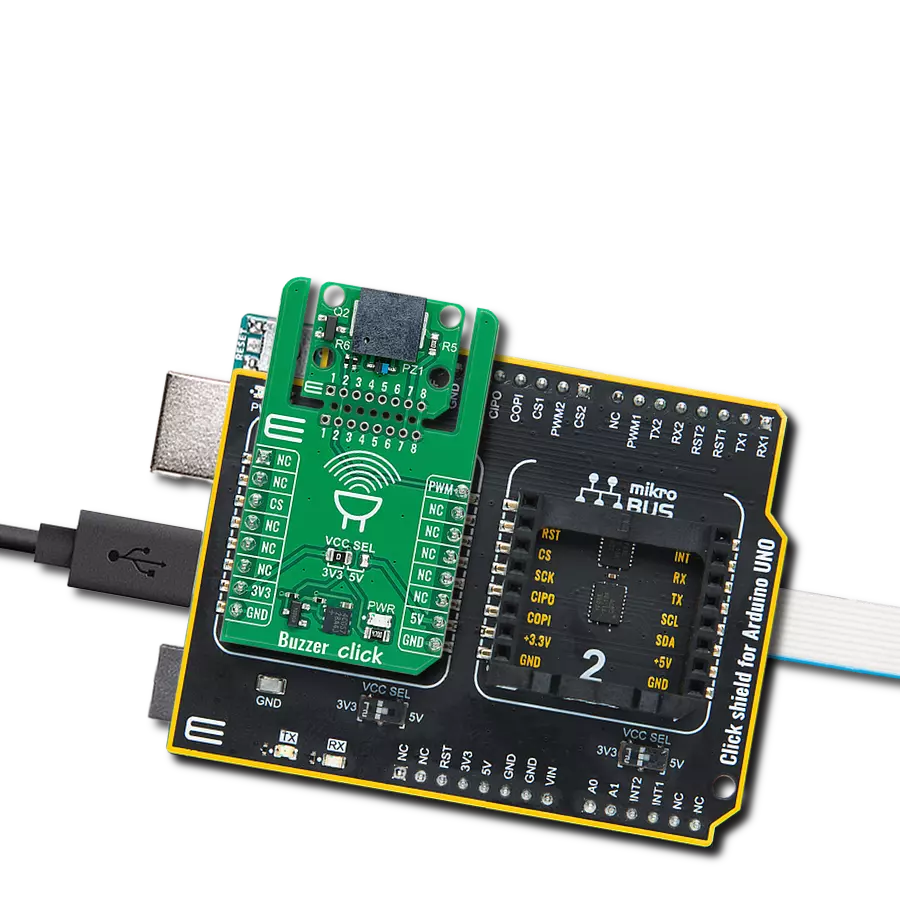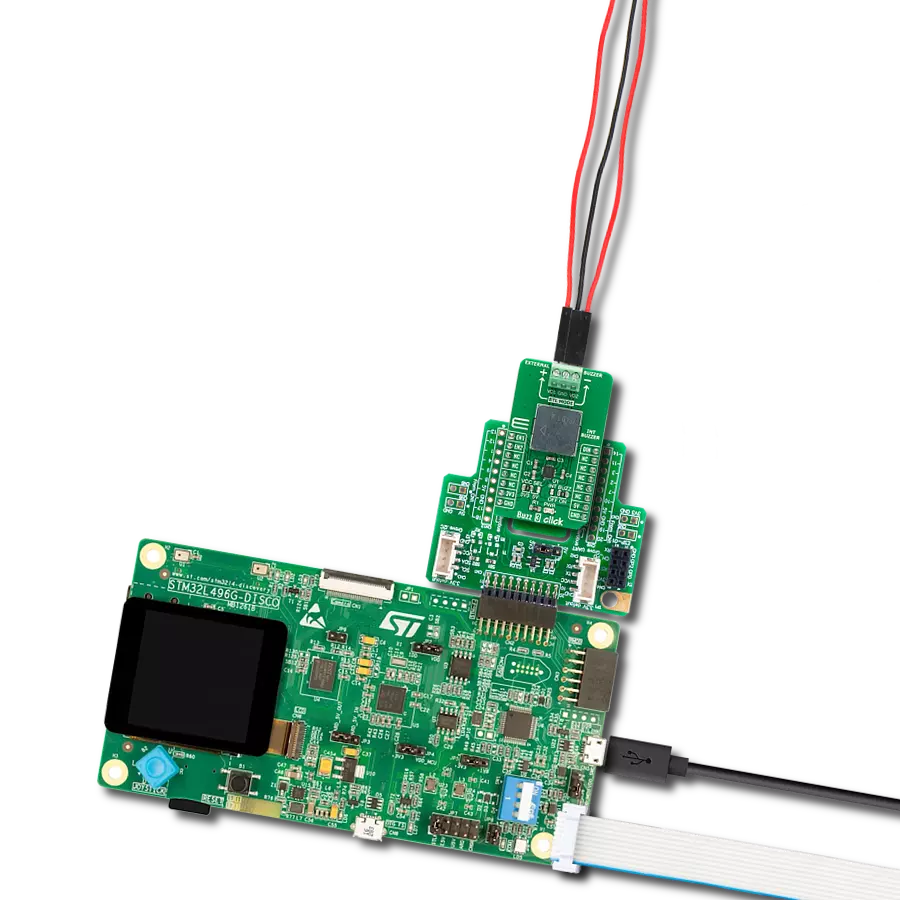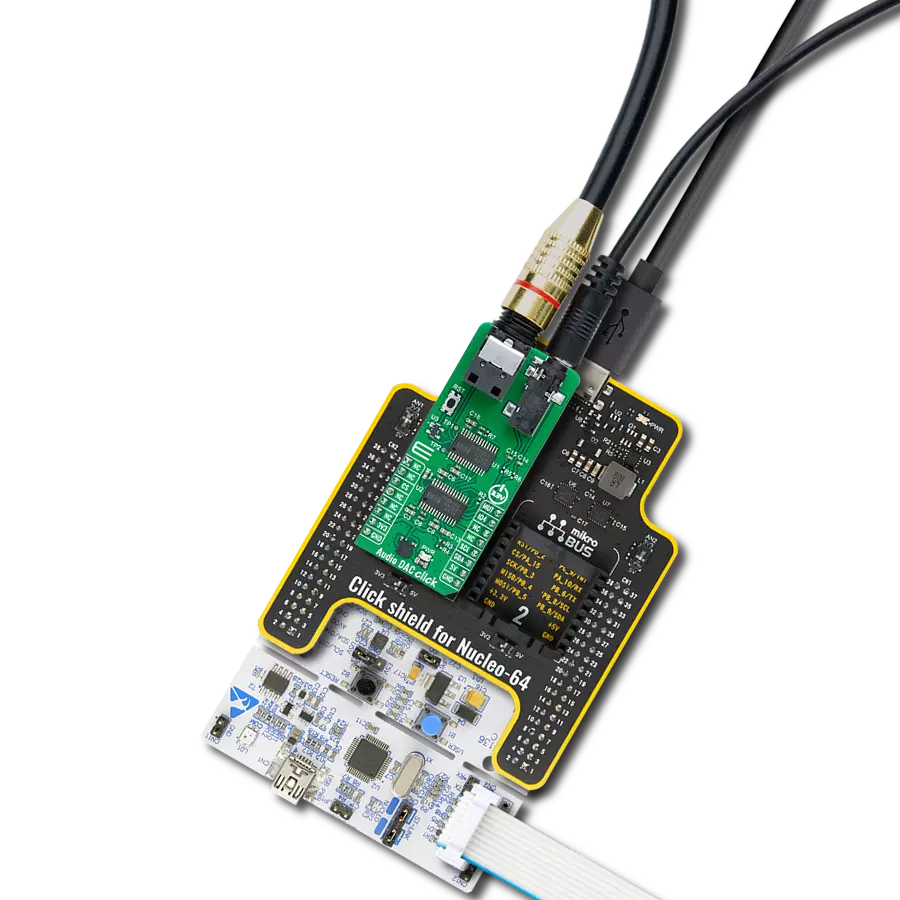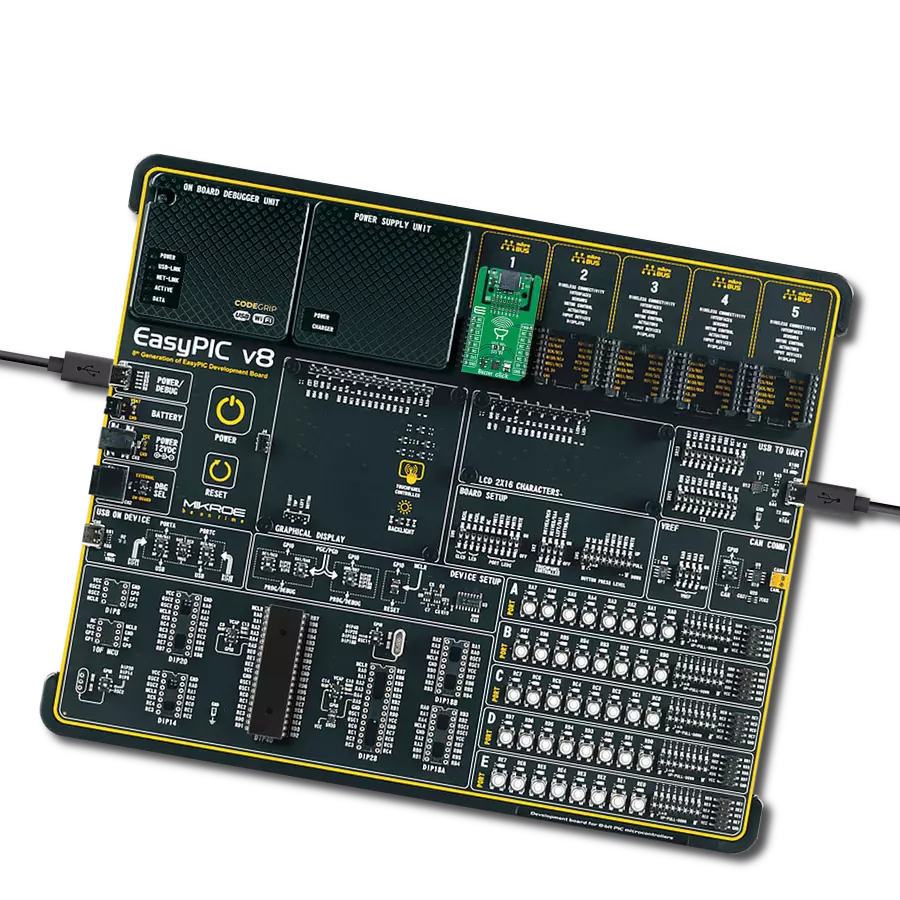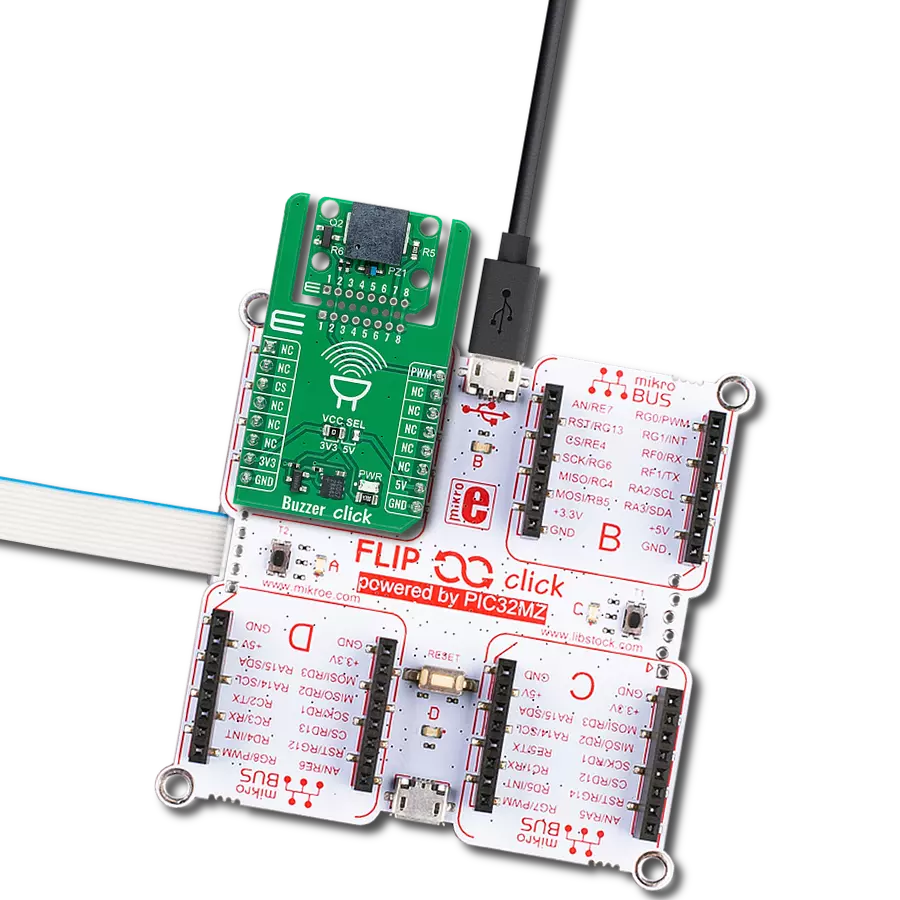Discover how our buzzer solution can revolutionize your daily life, from enhancing home security to streamlining industrial processes
A
A
Hardware Overview
How does it work?
BUZZ 2 Click is based on the CMT-8540S-SMT, a magnetic buzzer transducer from CUI Devices. The buzzer's resonant frequency is 4kHz. The click is designed to run on either a 3.3V or 5V power supply. The PWM pin on the mikroBUS™ line controls the CMT-8540S-SMT magnetic buzzer. You can create different sound patterns using
the Sound library supported in our compilers or utilize the microcontroller's internal PWM module to create the signal for the buzzer. Signal frequency determines the sound pitch, and the duty cycle determines the amplitude (sound volume). This Click board™ can operate with either 3.3V or 5V logic voltage levels selected via the
VCCIO SEL jumper. This way, both 3.3V and 5V capable MCUs can use the communication lines properly. Also, this Click board™ comes equipped with a library containing easy-to-use functions and an example code that can be used as a reference for further development.
Features overview
Development board
Clicker 4 for STM32F3 is a compact development board designed as a complete solution, you can use it to quickly build your own gadgets with unique functionalities. Featuring a STM32F302VCT6, four mikroBUS™ sockets for Click boards™ connectivity, power managment, and more, it represents a perfect solution for the rapid development of many different types of applications. At its core, there is a STM32F302VCT6 MCU, a powerful microcontroller by STMicroelectronics, based on the high-
performance Arm® Cortex®-M4 32-bit processor core operating at up to 168 MHz frequency. It provides sufficient processing power for the most demanding tasks, allowing Clicker 4 to adapt to any specific application requirements. Besides two 1x20 pin headers, four improved mikroBUS™ sockets represent the most distinctive connectivity feature, allowing access to a huge base of Click boards™, growing on a daily basis. Each section of Clicker 4 is clearly marked, offering an intuitive and clean interface. This makes working with the development
board much simpler and thus, faster. The usability of Clicker 4 doesn’t end with its ability to accelerate the prototyping and application development stages: it is designed as a complete solution which can be implemented directly into any project, with no additional hardware modifications required. Four mounting holes [4.2mm/0.165”] at all four corners allow simple installation by using mounting screws. For most applications, a nice stylish casing is all that is needed to turn the Clicker 4 development board into a fully functional, custom design.
Microcontroller Overview
MCU Card / MCU
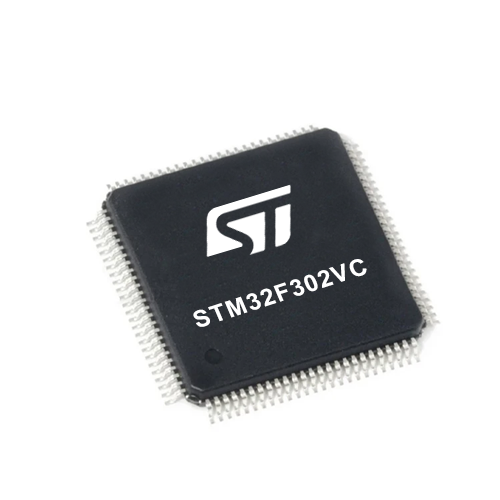
Architecture
ARM Cortex-M4
MCU Memory (KB)
256
Silicon Vendor
STMicroelectronics
Pin count
100
RAM (Bytes)
40960
Used MCU Pins
mikroBUS™ mapper
Take a closer look
Click board™ Schematic

Step by step
Project assembly
Track your results in real time
Application Output
1. Application Output - In Debug mode, the 'Application Output' window enables real-time data monitoring, offering direct insight into execution results. Ensure proper data display by configuring the environment correctly using the provided tutorial.

2. UART Terminal - Use the UART Terminal to monitor data transmission via a USB to UART converter, allowing direct communication between the Click board™ and your development system. Configure the baud rate and other serial settings according to your project's requirements to ensure proper functionality. For step-by-step setup instructions, refer to the provided tutorial.

3. Plot Output - The Plot feature offers a powerful way to visualize real-time sensor data, enabling trend analysis, debugging, and comparison of multiple data points. To set it up correctly, follow the provided tutorial, which includes a step-by-step example of using the Plot feature to display Click board™ readings. To use the Plot feature in your code, use the function: plot(*insert_graph_name*, variable_name);. This is a general format, and it is up to the user to replace 'insert_graph_name' with the actual graph name and 'variable_name' with the parameter to be displayed.

Software Support
Library Description
This library contains API for BUZZ 2 Click driver.
Key functions:
buzz2_set_duty_cycle- BUZZ 2 sets PWM duty cyclebuzz2_play_sound- Play sound functionbuzz2_pwm_start- BUZZ 2 start PWM module
Open Source
Code example
The complete application code and a ready-to-use project are available through the NECTO Studio Package Manager for direct installation in the NECTO Studio. The application code can also be found on the MIKROE GitHub account.
/*!
* @file main.c
* @brief Buzz2 Click example
*
* # Description
* This example demonstrates the use of Buzz 2 Click boards.
*
* The demo application is composed of two sections :
*
* ## Application Init
* Initializes the driver and logger.
*
* ## Application Task
* Plays the Imperial March melody. Also logs an appropriate message on the USB UART.
*
* @note
* The minimal PWM Clock frequency required for this example is the frequency of tone C6 - 1047 Hz.
* So, in order to run this example and play all tones correctly, the user will need to decrease
* the MCU's main clock frequency in MCU Settings for the certain architectures
* in order to get the required PWM clock frequency.
*
* @author Jelena Milosavljevic
*
*/
#include "board.h"
#include "log.h"
#include "buzz2.h"
#define W 4*Q // Whole 4/4 - 4 Beats
#define H 2*Q // Half 2/4 - 2 Beats
#define Q 250 // Quarter 1/4 - 1 Beat
#define E Q/2 // Eighth 1/8 - 1/2 Beat
#define S Q/4 // Sixteenth 1/16 - 1/4 Beat
#define VOLUME 100 // goes up to 1000
static buzz2_t buzz2;
static log_t logger;
static void imperial_march( )
{
buzz2_play_sound(&buzz2, BUZZ2_NOTE_A6, VOLUME, Q );
Delay_ms ( 1 + Q );
buzz2_play_sound(&buzz2, BUZZ2_NOTE_A6, VOLUME, Q );
Delay_ms ( 1 + Q );
buzz2_play_sound(&buzz2, BUZZ2_NOTE_A6, VOLUME, Q );
Delay_ms ( 1 + Q );
buzz2_play_sound(&buzz2, BUZZ2_NOTE_F6, VOLUME, E + S );
Delay_ms ( 1 + E + S );
buzz2_play_sound(&buzz2, BUZZ2_NOTE_C7, VOLUME, S );
Delay_ms ( 1 + S );
buzz2_play_sound(&buzz2, BUZZ2_NOTE_A6, VOLUME, Q );
Delay_ms ( 1 + Q );
buzz2_play_sound(&buzz2, BUZZ2_NOTE_F6, VOLUME, E + S );
Delay_ms ( 1 + E + S );
buzz2_play_sound(&buzz2, BUZZ2_NOTE_C7, VOLUME, S );
Delay_ms ( 1 + S );
buzz2_play_sound(&buzz2, BUZZ2_NOTE_A6, VOLUME, H );
Delay_ms ( 1 + H );
buzz2_play_sound(&buzz2, BUZZ2_NOTE_E7, VOLUME, Q );
Delay_ms ( 1 + Q );
buzz2_play_sound(&buzz2, BUZZ2_NOTE_E7, VOLUME, Q );
Delay_ms ( 1 + Q );
buzz2_play_sound(&buzz2, BUZZ2_NOTE_E7, VOLUME, Q );
Delay_ms ( 1 + Q );
buzz2_play_sound(&buzz2, BUZZ2_NOTE_F7, VOLUME, E + S );
Delay_ms ( 1 + E + S );
buzz2_play_sound(&buzz2, BUZZ2_NOTE_C7, VOLUME, S );
Delay_ms ( 1 + S );
buzz2_play_sound(&buzz2, BUZZ2_NOTE_Ab6, VOLUME, Q );
Delay_ms ( 1 + Q );
buzz2_play_sound(&buzz2, BUZZ2_NOTE_F6, VOLUME, E + S );
Delay_ms ( 1 + E + S );
buzz2_play_sound(&buzz2, BUZZ2_NOTE_C7, VOLUME, S );
Delay_ms ( 1 + S );
buzz2_play_sound(&buzz2, BUZZ2_NOTE_A6, VOLUME, H );
Delay_ms ( 1 + H );
buzz2_play_sound(&buzz2, BUZZ2_NOTE_A7, VOLUME, Q );
Delay_ms ( 1 + Q );
buzz2_play_sound(&buzz2, BUZZ2_NOTE_A6, VOLUME, E + S );
Delay_ms ( 1 + E + S );
buzz2_play_sound(&buzz2, BUZZ2_NOTE_A6, VOLUME, S );
Delay_ms ( 1 + S );
buzz2_play_sound(&buzz2, BUZZ2_NOTE_A7, VOLUME, Q );
Delay_ms ( 1 + Q );
buzz2_play_sound(&buzz2, BUZZ2_NOTE_Ab7, VOLUME, E + S );
Delay_ms ( 1 + E + S );
buzz2_play_sound(&buzz2, BUZZ2_NOTE_G7, VOLUME, S );
Delay_ms ( 1 + S );
buzz2_play_sound(&buzz2, BUZZ2_NOTE_Gb7, VOLUME, S );
Delay_ms ( 1 + S );
buzz2_play_sound(&buzz2, BUZZ2_NOTE_E7, VOLUME, Q );
Delay_ms ( 1 + Q );
buzz2_play_sound(&buzz2, BUZZ2_NOTE_F7, VOLUME, E );
Delay_ms ( 1 + E );
Delay_ms ( 1 + E );
buzz2_play_sound(&buzz2, BUZZ2_NOTE_Bb6, VOLUME, E );
Delay_ms ( 1 + E );
buzz2_play_sound(&buzz2, BUZZ2_NOTE_Eb7, VOLUME, Q );
Delay_ms ( 1 + Q );
buzz2_play_sound(&buzz2, BUZZ2_NOTE_D7, VOLUME, E + S );
Delay_ms ( 1 + E + S );
buzz2_play_sound(&buzz2, BUZZ2_NOTE_Db7, VOLUME, S );
Delay_ms ( 1 + S );
buzz2_play_sound(&buzz2, BUZZ2_NOTE_C7, VOLUME, S );
Delay_ms ( 1 + S );
buzz2_play_sound(&buzz2, BUZZ2_NOTE_B6, VOLUME, S );
Delay_ms ( 1 + S );
buzz2_play_sound(&buzz2, BUZZ2_NOTE_C7, VOLUME, E );
Delay_ms ( 1 + E );
Delay_ms ( 1 + E );
buzz2_play_sound(&buzz2, BUZZ2_NOTE_F6, VOLUME, E );
Delay_ms ( 1 + E );
buzz2_play_sound(&buzz2, BUZZ2_NOTE_Ab6, VOLUME, Q );
Delay_ms ( 1 + Q );
buzz2_play_sound(&buzz2, BUZZ2_NOTE_F6, VOLUME, E + S );
Delay_ms ( 1 + E + S );
buzz2_play_sound(&buzz2, BUZZ2_NOTE_A6, VOLUME, S );
Delay_ms ( 1 + S );
buzz2_play_sound(&buzz2, BUZZ2_NOTE_C7, VOLUME, Q );
Delay_ms ( 1 + Q );
buzz2_play_sound(&buzz2, BUZZ2_NOTE_A6, VOLUME, E + S );
Delay_ms ( 1 + E + S );
buzz2_play_sound(&buzz2, BUZZ2_NOTE_C7, VOLUME, S );
Delay_ms ( 1 + S );
buzz2_play_sound(&buzz2, BUZZ2_NOTE_E7, VOLUME, H );
Delay_ms ( 1 + H );
buzz2_play_sound(&buzz2, BUZZ2_NOTE_A7, VOLUME, Q );
Delay_ms ( 1 + Q );
buzz2_play_sound(&buzz2, BUZZ2_NOTE_A6, VOLUME, E + S );
Delay_ms ( 1 + E + S );
buzz2_play_sound(&buzz2, BUZZ2_NOTE_A6, VOLUME, S );
Delay_ms ( 1 + S );
buzz2_play_sound(&buzz2, BUZZ2_NOTE_A7, VOLUME, Q );
Delay_ms ( 1 + Q );
buzz2_play_sound(&buzz2, BUZZ2_NOTE_Ab7, VOLUME, E + S );
Delay_ms ( 1 + E + S );
buzz2_play_sound(&buzz2, BUZZ2_NOTE_G7, VOLUME, S );
Delay_ms ( 1 + S );
buzz2_play_sound(&buzz2, BUZZ2_NOTE_Gb7, VOLUME, S );
Delay_ms ( 1 + S );
buzz2_play_sound(&buzz2, BUZZ2_NOTE_E7, VOLUME, S );
Delay_ms ( 1 + S );
buzz2_play_sound(&buzz2, BUZZ2_NOTE_F7, VOLUME, E );
Delay_ms ( 1 + E );
Delay_ms ( 1 + E );
buzz2_play_sound(&buzz2, BUZZ2_NOTE_Bb6, VOLUME, E );
Delay_ms ( 1 + E );
buzz2_play_sound(&buzz2, BUZZ2_NOTE_Eb7, VOLUME, Q );
Delay_ms ( 1 + Q );
buzz2_play_sound(&buzz2, BUZZ2_NOTE_D7, VOLUME, E + S );
Delay_ms ( 1 + E + S );
buzz2_play_sound(&buzz2, BUZZ2_NOTE_Db7, VOLUME, S );
Delay_ms ( 1 + S );
buzz2_play_sound(&buzz2, BUZZ2_NOTE_C7, VOLUME, S );
Delay_ms ( 1 + S );
buzz2_play_sound(&buzz2, BUZZ2_NOTE_B6, VOLUME, S );
Delay_ms ( 1 + S );
buzz2_play_sound(&buzz2, BUZZ2_NOTE_C7, VOLUME, E );
Delay_ms ( 1 + E );
Delay_ms ( 1 + E );
buzz2_play_sound(&buzz2, BUZZ2_NOTE_F6, VOLUME, E );
Delay_ms ( 1 + E );
buzz2_play_sound(&buzz2, BUZZ2_NOTE_Ab6, VOLUME, Q );
Delay_ms ( 1 + Q );
buzz2_play_sound(&buzz2, BUZZ2_NOTE_F6, VOLUME, E + S );
Delay_ms ( 1 + E + S );
buzz2_play_sound(&buzz2, BUZZ2_NOTE_C7, VOLUME, S );
Delay_ms ( 1 + S );
buzz2_play_sound(&buzz2, BUZZ2_NOTE_A6, VOLUME, Q );
Delay_ms ( 1 + Q );
buzz2_play_sound(&buzz2, BUZZ2_NOTE_F6, VOLUME, E + S );
Delay_ms ( 1 + E + S );
buzz2_play_sound(&buzz2, BUZZ2_NOTE_C7, VOLUME, S );
Delay_ms ( 1 + S );
buzz2_play_sound(&buzz2, BUZZ2_NOTE_Ab6, VOLUME, H );
Delay_ms ( 1 + H );
}
void application_init ( void ) {
log_cfg_t log_cfg; /**< Logger config object. */
buzz2_cfg_t buzz2_cfg; /**< Click config object. */
/**
* Logger initialization.
* Default baud rate: 115200
* Default log level: LOG_LEVEL_DEBUG
* @note If USB_UART_RX and USB_UART_TX
* are defined as HAL_PIN_NC, you will
* need to define them manually for log to work.
* See @b LOG_MAP_USB_UART macro definition for detailed explanation.
*/
LOG_MAP_USB_UART( log_cfg );
log_init( &logger, &log_cfg );
log_info( &logger, " Application Init " );
// Click initialization.
buzz2_cfg_setup( &buzz2_cfg );
BUZZ2_MAP_MIKROBUS( buzz2_cfg, MIKROBUS_1 );
err_t init_flag = buzz2_init( &buzz2, &buzz2_cfg );
if ( init_flag == PWM_ERROR ) {
log_error( &logger, " Application Init Error. " );
log_info( &logger, " Please, run program again... " );
for ( ; ; );
}
buzz2_set_duty_cycle ( &buzz2, 0.0 );
buzz2_pwm_start( &buzz2 );
Delay_ms ( 100 );
log_info( &logger, " Application Task " );
}
void application_task ( void )
{
log_printf( &logger, "Playing the Imperial March melody ...\r\n" );
imperial_march( );
// 10 seconds delay
Delay_ms ( 1000 );
Delay_ms ( 1000 );
Delay_ms ( 1000 );
Delay_ms ( 1000 );
Delay_ms ( 1000 );
Delay_ms ( 1000 );
Delay_ms ( 1000 );
Delay_ms ( 1000 );
Delay_ms ( 1000 );
Delay_ms ( 1000 );
}
int main ( void )
{
/* Do not remove this line or clock might not be set correctly. */
#ifdef PREINIT_SUPPORTED
preinit();
#endif
application_init( );
for ( ; ; )
{
application_task( );
}
return 0;
}
// ------------------------------------------------------------------------ END
Additional Support
Resources
Category:Speakers
